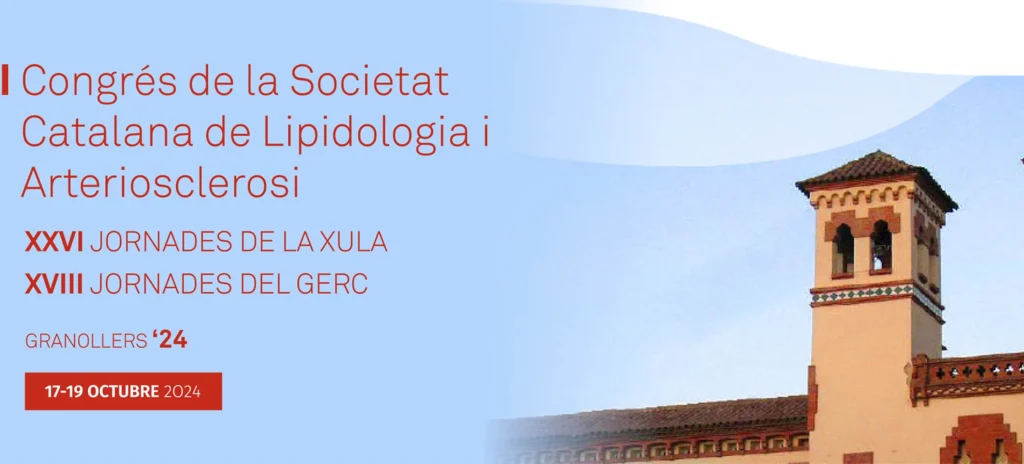The XXVI Jornadas of XULA (Xarxa d’Unitats de Lípids i Arteriosclerosi) are much more than just a scientific gathering. It is a space for exchange, where healthcare professionals, researchers, and experts in lipidology and atherosclerosis come together to discuss the latest advances in the treatment and prevention of cardiovascular diseases.
This year, the conference was held in Granollers and brought together an exceptional group of speakers and participants. All with a common goal: to share knowledge and experiences to improve the management of lipid metabolism disorders and cardiovascular risk factors. From innovations in lipid-lowering therapies to injury prevention in patients with dyslipidemia. The program covered a wide range of topics that directly impact the health of our patients.
What makes this congress special is not only the high scientific level but also the collaborative atmosphere that is created among colleagues. Here, dialogue, constructive debate, and above all, networking between professionals committed to the continuous improvement of cardiovascular medicine are encouraged.
Additionally, it is a source of pride to see how prevention is being addressed, focusing not only on LDL levels but also on a more comprehensive view of cardiovascular ris. Incorporating cutting-edge technologies such as artificial intelligence and metabolomics. These advances are destined to change the way we understand and treat these diseases, and the congress clearly demonstrates how they can be applied in practice.
For many attendees, this congress is also an opportunity to reconnect, be inspired by new approaches, and remember that innovation in medicine happens not only in laboratories but also in these spaces of shared learning.
Throughout the conference, several roundtables focused on key topics in lipidology and atherosclerosis. The program began with the first roundtable, titled “Controvèrsies XULA. Quines guies hem de seguir?”. Moderated by Dr. Lina Badimon Maestro, where Drs. Eduard Esteve Lafuente, Joan Pedro-Botet Montoya, and Xavier Pintó Sala discussed the different guidelines that should be followed in lipid management and cardiovascular risk, along with strategies for their implementation.
Later, the second roundtable, was titled “Innovació en el tractament hipolipemiant intensiu. Per què, com i a qui?”. Moderated by Dr. Lluís Masana Marín, innovations in intensive lipid-lowering therapies were discussed. Dr. Meritxell Royuela Juncadella explained why these therapies are necessary, Dr. Àlex Vila Belmonte talked about innovations with inclisiran, and Dr. Daiana Ibarretxe Gerediaga shared experiences with target patients in this context.
Following this, a third roundtable was held on “Risc cardiovascular residual. Prevenció més enllà de les LDL”. Moderated by Dr. Àngels Pedragosa Vall. In this session, Dr. Núria Amigó Grau addressed the impact of triglyceride-rich particles on cardiovascular risk, Dr. Miguel Cainzos Achirica delved into the relevance of residual cardiovascular risk, and Dr. Xavier García-Moll Marimon discussed a multifactorial therapeutic approach to persistent cardiovascular risk.
The fourth roundtable was “Pacient dismetabòlic: Obesitat, diabetis i dislipèmia”. Moderated by Dr. Carolina Guerrero Buitrago, the speakers addressed the evaluation of cardiovascular risk in patients with diabetes and dysmetabolism. Dr. Ana María González Lleó discussed cardiovascular risk in diabetics, Dr. Carlos Jericó Alba focused on the cardio-metabolic-renal triad. Dr. Laia Matas Pericas explained therapeutic objectives in dysmetabolic patients.
The following day, the roundtables continued with equally relevant topics. The fifth roundtable, titled “Fetge gras – Sdr. Metabòlica”, moderated by Dr. Elisabet Sánchez Pujol, discussed the implications of fatty liver in metabolic syndrome. Dr. Marta Alegret Jordà explained the pathophysiology and cardiovascular risk, Dr. Alba Martínez Escudé addressed diagnosis and epidemiology, and Dr. Virginia Esteve Luque discussed therapeutic perspectives.
The sixth roundtable, moderated by Dr. Mònica Vila Vall-llovera, was titled “Hipercolesterolèmia familiar: Del laboratori a la clínica”. Dr. Àlex Vila Belmonte presented the epidemiology and screening, Dr. Ariadna Padró Miquel spoke about genetic studies in familial hypercholesterolemia, and Dr. Cristina Soler i Ferrer explained the treatment of this condition.
The seventh roundtable, with the topic “Noves dianes terapèutiques pel control del risc cardiovascular”, moderated by Dr. Núria Plana Gil, focused on new therapeutic strategies. Dr. Maria Urquizu Padilla spoke about the management of Lp(a), Dr. Pere Rehues Masip addressed the treatment of severe hypertriglyceridemia, and Dr. Daiana Ibarretxe Gerediaga focused on the treatment of homozygous familial hypercholesterolemia.
Finally, in the eighth roundtable, titled “Intel·ligència artificial i medicina”, moderated by Dr. Esteve Llargués Rocabruna, the applications of artificial intelligence in the medical field were explored. Mr. Toni Alonso Solis and Dr. Esteve Llargués Rocabruna presented the latest advances in generative artificial intelligence and its impact on medicine.
